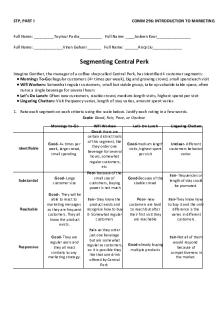Central dogma PDF

| Title | Central dogma |
|---|---|
| Author | Jocelyn Normand |
| Course | Biochemistry I |
| Institution | Plymouth State University |
| Pages | 4 |
| File Size | 280.9 KB |
| File Type | |
| Total Downloads | 46 |
| Total Views | 206 |
Summary
This is a worksheet in the central dogma from biointeractive....
Description
Central Dogma and Genetic Medicine
Click & Learn Student Worksheet
OVERVIEW This worksheet complements the Central Dogma and Genetic Medicine Click & Learn. PROCEDURE As you proceed through the Click & Learn, follow the instructions below and answer the questions in the spaces provided. 1. Let’s review! The central dogma of molecular biology refers to the process of gene expression. Write the definition of gene expression in your own words.
Information encoded in a gene is made into a functional molecule.
2. Click on the “Central Dogma” menu tab at the top of the screen. The table below outlines the steps in eukaryotic gene expression. Click on each tab or scroll through the page and briefly summarize each step below. Gene Expression Steps
Transcription
RNA Splicing
Molecules Involved What molecules and proteins are involved in this step?
RNA polymerase, DNA, RNA, intron, extron
Protein Processing
Genetics www.BioInteractive.org
A genes DNA is transcribed into and RNA transcript with complementary sequence by RNA polymerase.
Spliceosome, intron, extron, A sliceosome trims out introns and splices exons mRNA together to make mRNA.
mRNA
mRNA is trasported from the nucleus to the cytoplasm.
mRNA, tRNA, ribosome, polypeptide
The ribosome translates the mRNA code into amino acids that are added to a polypeptide chain by tRNA.
polypeptide
The polypeptide chain is folded into a funtional protein in the golgi or the endoplamic reticulum.
mRNA Transport
Translation
Summary What happens during this step?
Published January 2018 Page 1 of 4
Click & Learn Student Worksheet
Central Dogma and Genetic Medicine
3. Mutations in the DNA can affect the structure and function of proteins. Some mutations may even cause genetic diseases. Scientists and doctors can intervene at different points during gene expression to develop treatments for such genetic diseases—or genetic medicine. Let’s learn about the genetic medicines that are being developed. Select the “Genetic Medicine” tab located on the top right of the screen. Click on the tab corresponding to the genetic medicine(s) that your instructor assigns to you, or scroll through the interactive and click on the pink “+” sign labeled with that genetic medicine. Read the “Genetic Medicine” tab material, watch the video, and read the information in the “Learn more” link. Then, complete the appropriate row(s) below.
Genetic Medicine
CRISPRCas9
Short Summary Write a one-sentence summary of how this genetic medicine works.
A DNA sequence can be changed by cutting out or editing a gene.
Detailed Description Describe how this genetic medicine would be used to treat a genetic disease. (For example, mention how it would fix the disease-causing mutation and/or result in a functioning protein.)
CRISPR-Cas9 could be used to treat a genetic disease by tageting a specific sequence to be cut. Then scientists can take advantage of the cell's DNA repair mechanism to correct a disease- causing mutation.
A therapeutic gene is inserted into a modified virus, which is injected near the cells that need the replacement gene.
Gene therapy can be used to replace mutated genesso the cell can produce a functional protein.
Gene switches can alter gene expression by binding to different proteins.
This can be used to treat genetic disease by preventing a certain gene to be turned on or off.
Exon Skipping
Exon skipping removes a mutations from the mRNA by changing how the RNA transcript with the mutation is spliced.
Exon skipping drugs can cause the exon containing the gene mutation to be splicedout to allow for a partially functional protein.
This can be used to reduce the gene expression of a disease causing mutation.
RNA Interference
Small RNA segments target mRNA for destruction, which reduces gene expression of certain genes.
Small Molecule Drug
These molecules can be easiliy taken up by cells and bind to the active site of a mutated enzyme.
Small molecule drugs can block the negative effects of disease-causing proteins.
Gene Therapy
Gene Switches
Genetics www.BioInteractive.org
Published January 2018 Page 2 of 4
Central Dogma and Genetic Medicine
Click & Learn Student Worksheet
4. Now let’s learn about some of the diseases that may be treated using these genetic medicines. Scroll through the interactive and click on the pink “+” sign that is labeled with the disease(s) that your instructor has assigned to you. Next, click on the “Case Study” tab at the top to reveal information about the disease. Read the “Case Study” material, watch the video, and read the information in the “Learn more” link. Then fill in the appropriate row(s) in the table below. Name of Disease
What are the key characteristics of the disease and whom does it affect? How can the featured genetic medicine be used to treat the disease?
Leber Congenital Amaurosis
Leber Congenital Amaurosis causes extreme far-sightedness or blindness in 2-3 per 100,000 newborns. It is a rare genetic disease that is caused by a mutation on one of 20 genes that disrupts the process by which cells of the retina convert light to nerve signals. Gene therapy can be used to replace the mutated version of a gene to improve a patients vision.
Sickle Cell Disease
Duchenne Muscular Dystrophy
Huntington’s Disease
Cystic Fibrosis
Genetics www.BioInteractive.org
Sickle cell disease is caused by mutations for the gene β-globin, which is one of the two substituents for adult hemoglobin. Fetal hemoglobin is usually turned off shortly after birth, but by using gene switch technology could make it a source of functional hemoglobin in sickle cell anemia patients.
Duchenne muscular dystrophy is caused by mutations in a gene that code for protein dystrophin in muscle cells. People with the disease have prgressive muscle weakness and are typically wheelchairbound for life by their teens. Exon skipping drugs can be used to splice out the dytrophin mRNA to allow the cells the produce a partially functional protein.
Huntington's Disease causes a mutation in the huntingtin gene, which caused an abnormal protein to be made and causes brain cells to die.RNA interference can reduce the production of the mutant huntingtin geneby destroying the mutant mRNA.
Cystic fibrosis causes a thick sticky mucus that obstructs airways and glands, which provide a breeding ground for life threatening infections. It is caused by one of over 2,000 gene mutations that code for CFTR. Small molecule drugs can increase the amount of protein in the cell membrane and keep the CFT R channels open longer.
Published January 2018 Page 3 of 4
Central Dogma and Genetic Medicine
Click & Learn Student Worksheet
APPLY WHAT YOU HAVE LEARNED 5. You are a researcher working on a treatment for Hutchinson-Gilford progeria syndrome, an extremely rare genetic disorder that causes accelerated aging in children. Children with progeria generally appear healthy at birth but soon start growing more slowly than other children and lose their hair. Additional symptoms include stiffness of joints, heart problems, and stroke. These children typically die of heart disease at an average age of 13 years. Progeria is caused by a mutation in a single gene, called lamin A. Scientists have identified over 1,400 mutations in the lamin A gene that result in changes in transcription, RNA splicing, and/or protein production. Lamin A codes for a protein required for the structural support of the nuclear envelope in cells. Without a functional protein, the nuclear envelope becomes unstable, eventually damaging the nucleus and causing cells to die. Based on what you learned in this Click & Learn, propose a genetic medicine strategy you could develop to treat patients with progeria. Describe which step in gene expression you might target and why you would target that step, the intervention tool you would use, and explain how this strategy would treat the disease.
Gene editing could be used to treat patients with progeria. By using CRISPR, you could remove the mutation so it is not expressed, and the gene is corrected and producing functioning proteins.This would correct the gene before transcription and RNA spilcing. By using CRISPR, the cells of children with progeria would be fixed, so the children could live a longer life.
Genetics www.BioInteractive.org
Published January 2018 Page 4 of 4...
Similar Free PDFs

Central dogma
- 4 Pages

Worksheet central dogma
- 3 Pages

Central Dogma Grade 12
- 2 Pages

Central Park Five Essay
- 7 Pages

Segmenting Central Perk
- 2 Pages

Measures of Central Tendency
- 14 Pages

Central transport assignment
- 2 Pages

Caso Central Lechera Asturiana
- 3 Pages

Medidas DE Tendencia Central
- 9 Pages
Popular Institutions
- Tinajero National High School - Annex
- Politeknik Caltex Riau
- Yokohama City University
- SGT University
- University of Al-Qadisiyah
- Divine Word College of Vigan
- Techniek College Rotterdam
- Universidade de Santiago
- Universiti Teknologi MARA Cawangan Johor Kampus Pasir Gudang
- Poltekkes Kemenkes Yogyakarta
- Baguio City National High School
- Colegio san marcos
- preparatoria uno
- Centro de Bachillerato Tecnológico Industrial y de Servicios No. 107
- Dalian Maritime University
- Quang Trung Secondary School
- Colegio Tecnológico en Informática
- Corporación Regional de Educación Superior
- Grupo CEDVA
- Dar Al Uloom University
- Centro de Estudios Preuniversitarios de la Universidad Nacional de Ingeniería
- 上智大学
- Aakash International School, Nuna Majara
- San Felipe Neri Catholic School
- Kang Chiao International School - New Taipei City
- Misamis Occidental National High School
- Institución Educativa Escuela Normal Juan Ladrilleros
- Kolehiyo ng Pantukan
- Batanes State College
- Instituto Continental
- Sekolah Menengah Kejuruan Kesehatan Kaltara (Tarakan)
- Colegio de La Inmaculada Concepcion - Cebu






